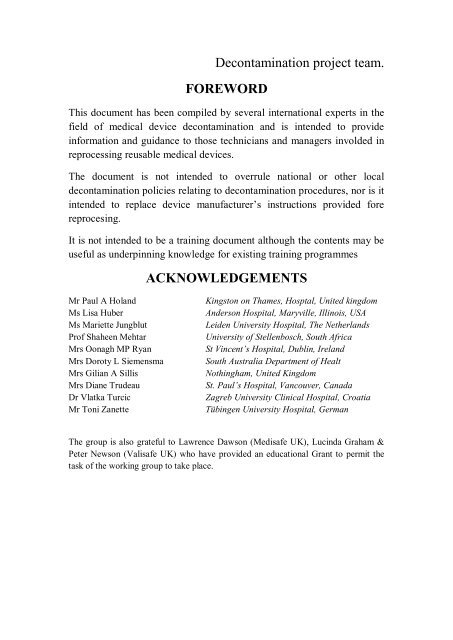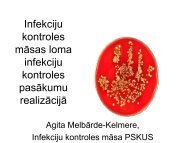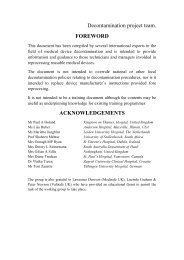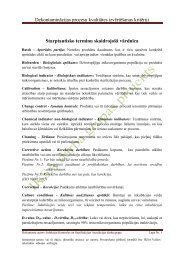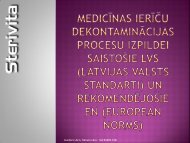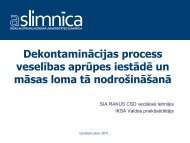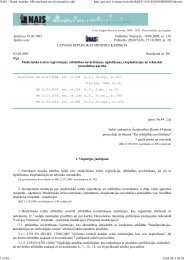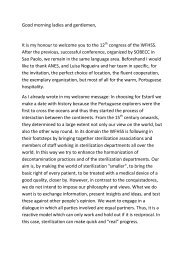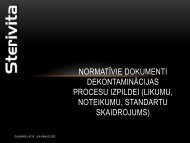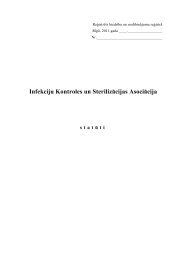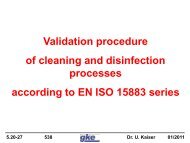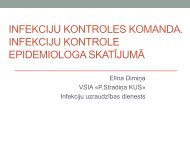Decontamination project team. FOREWORD ... - Sterivita.lv
Decontamination project team. FOREWORD ... - Sterivita.lv
Decontamination project team. FOREWORD ... - Sterivita.lv
Create successful ePaper yourself
Turn your PDF publications into a flip-book with our unique Google optimized e-Paper software.
<strong>Decontamination</strong> <strong>project</strong> <strong>team</strong>.<strong>FOREWORD</strong>This document has been compiled by several international experts in thefield of medical device decontamination and is intended to provideinformation and guidance to those technicians and managers involded inreprocessing reusable medical devices.The document is not intended to overrule national or other localdecontamination policies relating to decontamination procedures, nor is itintended to replace device manufacturer’s instructions provided forereprocesing.It is not intended to be a training document although the contents may beuseful as underpinning knowledge for existing training programmesACKNOWLEDGEMENTSMr Paul A HolandMs Lisa HuberMs Mariette JungblutProf Shaheen MehtarMrs Oonagh MP RyanMrs Doroty L SiemensmaMrs Gilian A SillisMrs Diane TrudeauDr Vlatka TurcicMr Toni ZanetteKingston on Thames, Hosptal, United kingdomAnderson Hospital, Maryville, Illinois, USALeiden University Hospital, The NetherlandsUniversity of Stellenbosch, South AfricaSt Vincent’s Hospital, Dublin, IrelandSouth Australia Department of HealtNothingham, United KingdomSt. Paul’s Hospital, Vancouver, CanadaZagreb University Clinical Hospital, CroatiaTübingen University Hospital, GermanThe group is also grateful to Lawrence Dawson (Medisafe UK), Lucinda Graham &Peter Newson (Valisafe UK) who have provided an educational Grant to permit thetask of the working group to take place.
1. IntroductionConcerns about risks of cross-infection have directed attention toissues of safe decontamination of medical devices from both thepublic and professional domainsMedical devices that can be safely and repeatedly decontaminated arevital, if potential risks of cross infection are to be managed.2. ScopeThe aim of this document is to provide risk based general guidance onthe minimum requirments for the safe decontamination of reusablemedical devices at point of use.This document highlights key steps in the decontamination of medicaldevices at point of use.3. Reasons for decontaminationThe need for scrupulous attention to decontamination procedures hasbeen highlighted internationaly for the medical and dental professionsas well as the public due to incidents of infections including HIV andHepatitis B and C. Therefore it is important that those undertakingdecontamination procedures should have an understanding of infectioncontrol practices carried out in their organisation. These practises aredesigned to reduce hte conditions, failure of care practices or, throughinappropriately prepared surgical instruments and other medicalequipment.The choice of decontamination method may be related to the infectionrisk associated with the intended use of the device; this shown im thefollowing table.Risk Aplication of item RecomendationHigh - In close contact with break in the skin Sterilizationor mucous membrane- Introduced into sterile body areasIntermediate - In contact with mucous membrane Sterilization os disinfection- Contaminated with particulary virulentor readly transmisible organismsrequiredCleaning may be acceptable in- Prior to use on immunocompromisedpatientssome agreed evidence basedsituations.Low - In contact with healty skin Cleaning
- Not in contact with patient4. General Requirements for <strong>Decontamination</strong>4.1. The Working environmentIt is important to ensure there is separation between the clean and dirtyactivity areas (see figure 2). There should be a one way directional flowwich invo<strong>lv</strong>es both people and products. There should be controlledHeating Ventilation and Air Conditioning (HVAC) and adequateprovisions of utilities (i.e. water, electricity).Materials used for constructing the department should be robust and easyto clean; floors and ceilings should be coved to promote easy cleanning;worktops should be made from nonlinting materials e.g. stainless steel.4.2. The <strong>Decontamination</strong> Process The process starts at the point of use – care should betaken that devices are safety contained fortransportation Receipt into decontamination area Initial sorting and disassembly of medical devices Cleaning process Inspection, testing, assembly and packaging Sterilization or disinfection Storage and distribution. Quality assurance and traceability of medical devices.
4.3. Workflow within <strong>Decontamination</strong> ServicesCRelated standart operatingprocedures (SOP)Receipt intodecontamination (SSD)FAILRelated standart operatingProcedures(SOP) NB:These C SOPs shouldinclude instrumentdisassembly andpreperation for cleanning,whether automated ormanual.CLEANINGPROCESSSELECTIONRelated standartoperating procedures(SOP)Related standart operatingprocedures (SOP)AUTOMATEDCLEANNINGMANUAL ONLYOR MANUALFOLLOWED BYAUTOMATEDCLEANNINGFAILRelated standart operatingProcedures(SOP) NB:These SOPs should alsoinclude device functiontests and maintentancechecks as defined bymanufacturersINSPECTIONASSEMBLY & PACKINGROOMFAILRelated standart operatingprocedures (SOP)STERILIZATIONFAILRelated standart operatingProcedures(SOP) NB:These SOPs should alsoprovide criteria coveringsafe product release intostorage or onwarddistribution...INSPECTFAILRelated standart operatingprocedures (SOP)STORE
4.4. Key processing Equipment4.4.1. Selection of equipment needs to be fit for intendedpurpose, installed, commisioned, operated andmaintained in accordance with the equipmentmanufacturer’s recomendations and any legalrequirements.4.4.2. Key processing equipment includes: Automated washer disinfectors including automatedendescope Ultrasonic Cleaners Heat sealing equipment Sterilizers4.4.3. All automated processes should be routinely monitored,mainted and documented.4.4.4. Verification / validation of equipment should be carriedout at least once a year.4.4.5. Policies and Standart Operating Procedures (SOP) shouldbe documented and based on Regulations and recognised,evidence based Standarts and current best practice4.5. Loan EquipmentLoan devices should be controlled and processed in the same manner asin-house items. There should be a policy for loaned instruments in placeto ensure patient safety. All supoting reprocessing documentation shouldbe adequate, appropriate, device specific and accompany the loandevices.4.6. Environmental cleanningDevelop & document a depertamental cleaning schedule: All work areas, stands, tables, countertops, sinks, and equipmentsurfaces should be cleaned daily. Floors must be cleaned daily. Sinks must be cleaned at the end of each shift as a minimum andmore frequently where necessary. Sinks used for clenning endescopes , respiratory equipment s mustbe throughly clenned between each use.
Spillages must be dealt with immediatley. All furniture should be easy to clean; only essential furnitureshould be presented.4.7. Raw Material Acquistion and storageRaw materials, e.g. cleanning chemicals, dressings, drapes, wrappers,indocators etc., should be obtained in accordance with local policies.Each category of material should be stored in clean,ventilated,temperature controled storage and folowing the supplier’sinstructions for storage. The store should be kept secure. Care should betaken to ensure shiping containers are removed from materials prior to thematerials entering user work areas; raw materials to be used in theinspection, assembly and packing area(IAP), must be protected within thearea until they are required.5. Key Stages of Processing5.1. Key Stage 1 – Procedures at Point of use5.1.1. All devices that have either been opened and/or used shouldbe regarded as contaminated and therefore a potential hazard.5.1.2. Sharps, single use devices and disposable products must beremoved and discared at point of use. Place sharps in punctureproof containers and dispose off in accordance with local policy.5.1.3. Gross debris should be removed from medical devices andany pre-treatment recommended by the device manufacturerundertaken at point of use. This can be achieved by either soaking,rinsing, wiping or flushing. Do not use saline.5.1.4. rinsing should be conducted below 35 degrees Celsius toavoid coagulation of proteins.
5.1.5. flushing is specifically required for lumen instruments orMIS (minimaly invasive surgery) to prevent soil drying andadhering within the lumen.5.1.6. used devices should be placed in a closed leak proofcontainer ready for transportation. These containers may be only bereused after cleaning5.1.7. Ideally devices schould be transported in moist condition butwithout exess liquid.5.1.8 Fragile items should be protected during transortation5.2. Key Stage 2 – Receipt into <strong>Decontamination</strong> Area5.2.1. Unload received items carefully to avoid personal injury ordamaged to devices.5.2.2. Sort and prioritise medical devices based on facility and userrequirement.5.2.3. Disassemble and/or pre-clean where indicated. Specialattention should be given to all lumen instruments.5.3. Key Stage 3 – cleaning and Disinfection ProcessLeaning is a process intended to physically remove organic matter andinfectious agents from devices. Since the process is dependent upon manyfactors, where automated washer disenfectors or endescope reprocessorsare used, an integral thermal of chemical disinfectant cycle is used toensure devices are fit to handle.5.3.1. Criteria for cleanning:The following should be considered:- The potential level of contamination(bioburden) Type of processing equipment available
Types of medical devices to be processed Best possible water quality available5.3.2. Water quality , pressure and storage:a) Quality – water should be tested for hardness, pH, mineral andchemicals and microbal content; either in house or by anexternal service.b) Pressure- high pressure nozzle required for lumen items (5 bar75 psi)c) Water storage – in a closed container where the contents aremoved within 24 hours to avoid cantamination (biofilm) andstagnation.5.3.3. Choice and aplication of detergentsa) Detergents should be compatiable with water quality, cleaningequipment and devices to be cleanedb) The parameters of the process (time an temperature) will bedetermined by the type of detergentc) Selection of detergent may be Alkaline, Enzymatic or neutrald) Concentration, temperature and time – must be used asrecomended by the manufacturer.5.3.4. Methods of cleaning.There are two methods of cleaning:- Manual cleaning Use of an automated washer disinfector. Automated methodsare preferred where availablene since they are controlledprocesses which can be validated.5.3.4.1. Manual cleaningThere are two purposes of manual cleaning; As pre-cleaning prior to using an automated washerdisinfector As a cleaning method where other methods are not availableor appropriate.
Methods: Immersion Non immersion( see apendix 1)5.3.5.2.Routine Daily WD performance tests and practicesinclude:a) Mechanical function test i.e. spray arms are clean and freemoving, clean drain, check filters, check racks for debris,door sealsb) Check water supply and pressure.c) Check detergent levels and ensures detergent lines isconnected and dispensing.5.3.5.3. loading and load configurationDevices must be loaded in such a way that allows the cleaningsolution (water and detergent) to reach all surfaces of the loadand spray arms to move freely. All lumen devices must beconnected and secured properly. If connection of lumen is notpossible hollow items should be first cleaned manually and theprocessed.5.2.5.4. Choice of correct cycle depends on the type of medicaldevice being processed5.2.5.5. Machine specific racks and manifolds must be used.5.2.5.6. Instrument wash baskets must fit the rack and also holdthe largest item to be cleaned5.3.6. Use of Ultrasonic CleanersUltrasonic cleanners are available either as stand-alone units or as anintergal part of an automated process; ultrasound is a usefull methodfor clening lumen and micro surgery devices as well as pre-cleaningfor devices such as orthopaedic reamers. The units must be located in the clening area of thedecontamination facility Methodology – see apendix 2
5.3.7. DisinfectionAfter clening, devices need to be disinfected to render the safe forfuther handling. Disinfection may be achieved either by the use ofan approriate disinfectantsolution,or, where automated washerdisinfections are used, in the thermal rinse cycle of the machine.5.4. Key stage 4 – Inspection, Assembly and packing (IAP)This is the area within the department wich has the highhestenvironmental standarts in order to protect medical devices from recontamination during their inspection, reassembly of devices, testing,cheking set content and packing.5.4.1. inspection of all products for cleanliness Use magnification for fine and delicate instruments. Check functionality – lubrication, replace and repair. Assemble sets according to packing list Place chemical indicator in every pack as per nationalrecommendations Wherever possible, dressing and draping materials should notbe included in surgical instrument sets. Where these have to beincluded, they should be independently wrapped within thepack.5.4.2. PackagingPackaging is essential to maintain of sterility of medical devices untilopened at point of use. The type and method of packaging should enableboth the sterilant to penetrate the package and allow the aseptic removalof contents.Packaging material should be:- Suitable for size and weight of devices to be packed Compatible with sterilization processes Strong enough to withstand sterilization, transportation, storage, topoint of use application Capable of bearing a label to show contents, process date andmanufacturing facility
Enable application of external indicators for process control toidentifity that an item has been processed Permit adequate sealing of the pack to ensure integrity.5.5. Key stage 5 – terminal processing (sterilization or highlevel disinfection)Sterilization is the final step in the decontamination processing ofreusable medical devices and renders them safe for intended use. This isgenerally achieved using a stream autoclave wich is suitable for themajority of reusable devices. For those devices wich are heat and/orpresure sensitive, other methods of low temperature sterilizator may beused. In the case of flexible endescopes it is common to use a sporicidaldisinfectant to achieve high level disinfection of the device.5.5.1. S<strong>team</strong> autoclave5.6.1.1. Daily testsa) A warm up cycle should be carried out at the beginningof each working day or according to localrecomendationsb) Check the inside chamber for damage including the drain( visual check)c) Check door seals intact (wipe with a lint free cloth)d) Perform air leak test once a month or according to localrecomendationse) Undertake Bowie Dick or equivalent s<strong>team</strong> penerationtest daily (only for prevacuum s<strong>team</strong> sterilizers)NB There are no daily s<strong>team</strong> peneration tests for downwarddisplacement/gravity Machines5.5.2 mechanism for loading and unloading sterilizers:Use trolleys/carriges/baskets that are specific to the sterilizer beingused and validated.5.5.3. Correct load configuration is required to ensure effective airremoval and s<strong>team</strong> peneration to the entire load. Factor forconsideration are:
a) Heavy items to be placed lower than the lighter items other wiseitems may be wet after the sterilization process.b) Place peel pouches on their side, paper to paper or if necesarryto lie flat, place with paper side down.c) Do not overload ( pack loosely – no stacking ) as it maycompromise s<strong>team</strong> peneration.d) Loads must not touch any surface of the chambere) Rigid container systems should not be stacked unless they weredesigned for that purpose.f) Surfaces that could collect water, such as the bottoms of pans ortrays, must be positioned sideways (unless otherwise specifideby the manufacturer) so that any condensate that is present willdrain out.g) Mixed loads may be more dificult to achiee s<strong>team</strong> peneration.5.5.4. choice of sterilization cycle is depend ent on load contentand local recomendations5.5.5. Prior to release of the load, check and record Sterilization cycle printout ( time, temperature and presure) Process indicators Packaging intergrity Dryness of packs5.5.6. Low temperature sterilization (Ethylene oxide/Formaldehyde/Hydrogen Peroxide Technologies/Irradation/Ozone)are very specific sterilization processes and guidance from themanufacturers must be applied.5.5.7. Disinfectants for use in automated endescope reprocessors,or for high level terminal disinfection of endescopes will dependon local policy and preferences.5.6 Key stage 6 – Storage and distribution of processed goods5.6..1 Storage;Following sterilization packs are vulnerable and must therefore betreated with care; they should not be handled until cooled. Thereafter packs should be handled as little as possible and stored in
clean, pest and vermin free, secure and dry conditions to keep themfree from recontamination prior to distributionThe following point should be considered; Store away from direct sunlight. Have good internal air circulation Open racks rather than wooden she<strong>lv</strong>es are recomended. (bottom shelf should not be below 12 inches (300 mm) fromthe floor and 18 inches ( 45 cm ) from the ceiling Windows and doors in the storage area must be kept closed Clean and steril item smust not be stored on the floor, onwindow sills, near or under sinks. Prevention of recomentamination by storing correctly toavoid damage to packs Position the she<strong>lv</strong>es and racks to hold items so that they donot touch surfaces such as walls, floor, ceilings and lightsand water sprinklers Sterile and non-sterile products should not be stored togheter Stock rotation – first-in-first-out(FIFO) principle Access to the storage area must be restricted to personswhose normal responsibilities require them to enter this area.Persons in street attire must not be allowed into the storagearea5.6.2. DistributionThis may be internal or external to the arganisation and may ormay not be under the direct responsibility of the sterile servicesdepartamentKey considerations include: Dispatch in a manner that maintains the intergrity of medicaldevice Secure and robust transportation systems A system for product recall should be in place Optimum storage conditions at point of use
6. Quality Assurance and ControlIncluded in this section ;-6.1. Quality management system6.1.1. Documentation and record keeping6.1.2. Device tracking and tracebility6.1.3. Product release system6.2. Infection Prevetion and control6.3. Ocupation Health and Safety6.4. Education and Training of staff6.5. Risk Management6.1. Quality Management6.1.1. Documentation and Record Keeping – this include QualityPolicy Document, Quality Control Procedure followed by StandingOperating Procedures(SOPs). Records of all activities should bedocu ented and maintained for the required legal period.6.1.2. Device Tracking ans Tracebility – a valid system for trackingand tracebility (to the patient and back to reprocessor) is an intergalpart of patient safety requirements however simple it should enablethe use of a medical device to be recalled if required.6.1.3. Product Release System – refers to the integrated system oftests, controls and back up procedures intended to ensure thatreprocessed medical devices are fit for use.6.2. Infection Prevetion and Control – Staff need to be aware of; Infection prevertion policy and provision within facility Provision and practice for hand hygiene Dress codes, personal hygiene and use of Personal ProtectiveEquipment(PPE) Waste management ( clinical and non clinical )policies Safe disposal of sharps Incident reporting mechanisms Environmental control and testing.6.3. Occupation Health and Safety Pre employment questionnaire where legally required for healthclearance
Facility provided uniform should be worn and should preferablybe lint free Appropriate Personal Protective Equipment ( PPE) muste neworn in the designated area of the SSD according to the nationaland local requirements.6.3.1. In the decontamination cleaning area this will normallyconsist of:-a) Waterproof gowns/apronb) Hair coveringc) Gloves- preferably made from chemically inert material(nitrile)d) Eye and facial protectione) Robust footwear () open sandals are not recommended)6.3.2. Inspection Assembly & Packing area:-a) Hair coveringb) Clean overgown or uniform made from lint free material6.3.3. Sterilization areaa) Uniformb) Heat resistant6.4. Education and training of staff.In the interests of patient and personal safety, it is important that thoseworking within <strong>Decontamination</strong> Services (SSD) have sufficientnummeracy, literacy, comprehension and dexterity skills to fulfil theirrole within the facility and meet any legal requirements.Effective and appriorate training and competency assessmentprogrammes should be in place to support all grades of personnel andhelp career and personal development within the field.6.5. Risk management.Ensure that any devitations from normal operating procedures, such aserrors and accidents, are identifited, investigated and evaluated, and that
any corrective and preventative action (CAPA) is taken when requiredand documented.Terms and definitions Batch7. Glossary of TermsDefined quanty of product, intended or purported to be uniform incharacter nad quality, wich has been produced during a defined cycle ofmanufacture BioburdenPopulation of viable microorganisms on or in product and /or sterilebarrier system Biological indicatorTest system containing viable microorganisms providing a definedresistance to a specified sterilization process CalibrationSet of operations that establish, under specified conditions, therelationship between values of a quantity indicated by a measuringinstrument of measuring instrument or measuring system, or valuesrepresented by a material measure or a reference material, and thecorresponding values relized by standarts Change controlAssessment and determination of the appropriatness of a proposedalteration to product or procedure Chemical indicatorNon-biological indicator test sistem that reveals change in one or morepre defined process variables based on a chemical or physical changeresulting from exposure to a process.
CleaningRemoval of contamination from an item to the extent necessary forfurther processing or for intended use Corrective actionAction to eliminate the cause of a detected nonconformity or otherundesirablesituationNOTE 1 There can be more than one cause for a nonconformity.NOTE 2 Corrective action is taken to prevent recurrence whereaspreventive action is taken to prevent occurence. CorrectionAction to eliminate a detected nonconfirmity.NOTE A correction can be made in conjunction with a corrective action Culture conditionsCombination of growth media and manner of incubation used to promotegermination, growth, and/or multiplication of microorganisms.NOTE The manner of incubation may include the temperature, time andany other conditions specified for incubation. D valueD10 value time or dose required to achieve inactivation of 90% of apopulation of the test microorganisms under stated conditions Design qualificationVerification that the proposed specification for the facility, equipment, orsystem is suitable for the intended use. DevelopmentAct of elaborating a specification Evironmental controlApplication of engineering and/or procedural systems to maintainconditions in defined areas within specified limits. NOTE Such systems
can include air and fluid filters, surface disinfection, protective chlothingand administrative prcedures. EstablishDetermine by theoritical evalution and confirm by experimentation periodfor wich the process parameters are mainted within their specifiedtolerances. FaultOne or more of the process parameters lying outside of its/their specifiedtolerance(s) Health care product(s)Medical device(s), including in vitro diagnostic medical device(s), ormedicinal product(s), including boipharmaceutical(s) InactivationLoss of ability of microorganisms to grow and/or multiply Installation qualificationIQ process of obating and documenting evidence that equipment has beenprovided and installed in accordance with its specification. Material safety data sheetMSDS document specifyng the properties of a substance, its potentialhazardous effects for humans and the environment, and the precautionsnecessary to handle and dispose of the substace safety Medical deviceInstrument, apparatus, implement, machine, appaliance, implant, in vitroreagent or calibrator, software, material, or other related article, intendedby the manufacturer to be used, alone or in combination, for humanbeings for one or more of the specific purpose(s) of:- Diagnosis, prevention, monitoring, treatment, or alleviation ofdisease;
- Diagnosis, monitoring, treatment, allevation of, or compensationfor an injury;- Investigation, replacement, modification, or support of the anatomyor of a physiological process;- Supporting or sustaining life;- Control of conception;- Disinfection of medical devices;- Providing information for medical purposes by means of in vitroexamination of specimens derived from the human body;And wich does not achieve its primary intended action in or on the humanbody by pharmacological, immunlogical or methabolic means, but wichmey be assisted in its unction by such means (ISO 13485:2003) NOTEThis definition from ISO 13485:2003 was developed by the GlobalHarmonization Task Force (GHTF 2002). Microbial characterizationProcess by wich microorganisms are grouped into categories. NOTECategories can be broadly based, for ezample, on the use of selectivemedia, colony or cellular morphology, stanining properties, or othercharacteristics MicroorganismEntity of microscopic sixe, encompasing bacteria, fungi, protozoa, andviruses. NOTE A specific standart might not require demonstration of theeffectiveness of the sterilization process in inactivating all types ofmicroorganisms, identified in the definition above, for validation and/orroutine control of the sterilization process. Operational qualificationOQ Process of obtaining and documenting evidence that installedequipment operates within predetermined limits when used in accordancewith its operational procedures Packaging systemCombination of the sterile barrier system and protective packaging
Parametric releaseDeclaration that product is sterile, based on records demonstrating thatthe process parameters were delivered within specified tolerances Performance qualificationPQ process of obtaining and documenting evidence that the equipment,as installed and operated in accordance with operational procedures,consistenly performs in accordance with predetermined criteria andthereby yields product meeting its specification Preformed sterile barrier systemSterile barrier system that is suplied partially assembled for filling andfinal closure or sealing EXAMPLES Pouches, bags and open reusablecontainers. Preventive actionAction to eliminate the cause of a potential nonconformity or otherundesirable potential situation.NOTE 1 There can be more than one cause for a potential nonconfimity.NOTE 2 Preventive action is taken to prevent occurrence whereascorrective action is taken to prevent recurrence. (ISO 9000:2005) 2.33 Process challenge devicePCD item designed to constitute a defined resistance to a sterilizationprocess and used to assess performance of the process. Process parameterSpecified value for a process variable NOTE The specification for asterilization process includes the process parameters and their tolerances. Process variableCondition within a sterilization process, changes in which altermicrobicidal effectiveness. EXAMPLES Time, temperature, pressure,concentration, humidity, wavelength.
ProductResult of a process.... NOTE For the purposes of sterilization standarts,product is tangible and can be raw material(s), intermediate(s), subassembly(ies),and health care product(s). Protective packagingConfiguration of materials designed to prevent damage to the sterilebarrier system and its contents until the point of use Refrence microorganismMicrobal strain obtained from a recognized culture collection RequalificationRepetion of part of validation for the purpose of confirming the continuedacceptability of a specified process ServicesSupplies from an external source, needed for the function of equipmentEXAMPLES Electricty, eater, compressed air, drainage. SpecifyStipulate in detail within an aproved document SterileFree from viable microorganisms Sterile barrier systemMinimum package that prevents ingress of a microorganisms and allowsaseptic presentation of product at the point of use SterilityState of being free from viable microorganisms NOTE In practice, nosuch absolute statement regarding the absence of microorganisms can beproven
Sterility assurance levelSAL probability of a single viable microorganism occuring on an itemafter sterilization .NOTE The term SAL takes a quantive value, generally 10-6 or 10-3.When applying quantitative value to assurance of a sterility, an SAL of10-6 has lower value but provides a greater assurance of sterility than anSAL of 10-3. SterilizationValidated process used to render product free from viablemicroorganisms NOTE In a sterilization process, the nature of microbialinactivation is exponential and thus the survival of a microorganism on anindividual item can be expressed in items of probality. While thisprobality can be reduced to a very low number, it can never be reduced tozero. Sterilization loadProduct to be, or that has been, sterilized togheter using a givensterilization process Sterilization processSeries of actions or operations needed to achieve the specifiedrequirements for sterility NOTE This series of actions includes pretreatmentof product (if necessary), exposure under defined conditions tothe sterilizing agent and any necessary post treatment. The sterilizationprocess does not include any cleaning, disinfection, or packagingoperations that precede sterilization. Sterilizing agentPhysical or chemical entity, or combination of entities having sufficientmicrobicidal activity to achieve sterility under defined conditions Survivor curveGraphical represantation of the inactivation of a population ofmicroorganisms with increasing exposure to a microbicidal agent understated conditions
Terminal sterilizationProcess whereby product is sterilized within its steril barrier system Test or sterilityTechnical operation defined in a pharmacopoedia performed on productfollowing exposure to a test of sterility. Technical operation performed aspart of development, validation, or requalification to determine thepresenceor absence of viable microorganisms on product or portionsthereof ValidationDocumented procedure for obtaining, recording and interpreting theresults required to establish that a process will consistenly yield productcomplying with predetermined specifications.8. Useful referencesEN 285:2006 Sterilization. S<strong>team</strong> sterilizers. Large sterilizersISO 11138 - Sterilization of health care products – Biological indicatorsISO 11140 –Sterilization of health care products – Chemical indicatorsISO 11607 – Packaging for terminally sterilized medical devicesISO 13485 – Medical devices – Quality management systems –Requirements for regulatory purposesISO 15882 – Sterilization of health care products – Chemical indicators –Guidance for selection, use and interpretation of resultsISO 15883 – Washer-disinfections – Requirements and tests for washerdisinfectorsISO 17664 – Sterilizator of medical devices – Information to be providedby the manufacturer for the processing of resterilizable medical devicesISO 17665 – Sterilization of health care products – Moist heatIn addition to the above there are number of National and Regionalstandarts snd recommendations that apply.
Appendix 1Method for Manual Cleaning1. Esential equipment Waterproof Personal Protective Equipment (PPE) including gloves,visor, gown or apron must always be worn. Footwear and haircover as per local recommendations. . Two sinks or other receptacles (one for washing and one forrinsing) of sufficient size to hold the cleaning solution and immerseproducts to be cleaned if required. A suitable surface to drain products after rinsing. Reusable good quality brushes which can withstand daily cleaningand thermal disinfection should be used and inspected for damegeafter use. Metal brushes should not be used as they damageinstruments. Where possible, single use brushes are preferred. Lint free cleaning and drying cloths should be used and inspectedfor damage and soil after each use.2. Method2.1 Immersion :)(wearing PPE)‣ Fill the sink (not wash-hand basid) or other appropriate receptaclewith sufficient warm water to enable complete immersion of thedevice to be washed. An appropriate detergent should be added atthe manufacturer’s recommended dose for the volume of waterbeing used.‣ Immerse the item fully to displace air as all surfaces must beexposed to the washing solution.‣ Using brushes, clothes and water jet sprays where necessary (underthe solution surface to avoid the risk of aerosol) remove all visiblecontamination‣ Remove the product from the solution and drain over the washsolution before passing to the rinse sink.‣ Rinse throughly with fresh water (whist still ensuring the product isunder water) and the place on the draining surface.‣ Hand-drey using a clean, absorbent, non linting cloth.
2.2 Non-immersion(wearing PPE)‣ If the medical device is electrical, ensure that it is not connected toany power outlet and any protective caps for power inlets are inplace before beginning cleaning‣ Starting withnthe upper parts to the product, wipe surfacesthoroughly with the washing solution whilst ensuring that no liquidanter critical areas, including air or power inlets. Rinse the cleaningcloth periodically and repeat the above process until all visible soilis removed.‣ Rinse the product using a fresh cloth and clean water.‣ Dry the product with a clean non linting cloth.‣ Dispose of any single-use cleaning materials in accordance withlocal guidelinesNB: The cleaning solution and rinse water must be changed when visiblysoiled.2.3. Chemical disinfection If disinfection is the last step before use it should always followmanual cleaning. Disinfection after manual cleaning is to protected the staff. Wipethe otem with 70% isopropyl alchocol and allow to dry. Thedisinfection effect is the vaporisation of alchocol.Материал для публикации подготовила Байба Лаце


